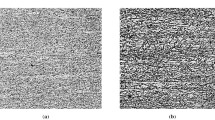Abstract
The present paper concerns a new method for determining the cold-brittleness temperatureT cb in tests for impact toughness. Results of estimation of metal quality based on conventional characteristics and the suggested parameter of resistance to defects are compared for ship steels 10KhSND and 12KhN3. Impact toughness is essentially an integral characteristic of a metal. The energy capacity of fracture depends on the strength and ductility simultaneously, as well as on the test conditions and the shape of the specimen, which in many cases makes estimation of metal quality ambiguous. The authors consider nontraditional approaches to determination of the embrittlement action of various stress concentrators. The aim of the work consists in establishing a relation between the universally used mechanical properties determined in impact toughness tests and toughness parameters such asK t (toughness coefficient) andD 2 (resistance to defects).
Similar content being viewed by others
References
V. D. Sadovskii,Structural Inheritance in Steel [in Russian], Metallurgiya, Moscow (1973).
E. M. Shevandin, “A method for estimating the susceptibility of steel to brittle fracture from the kind of fracture surface,”Zavod. Lab., No. 2, 1497–1512 (1959).
A. P. Gulyaev and V. N. Nikitin, “Estimating the quality of steel from results of impact tests of notched specimens,”Zavod. Lab., No. 7, 885–889 (1964).
Yu. Ya. Meshkov and G. A. Pakharenko,Structure of Metals and Brittleness of Steel Parts [in Russian], Naukova Dumka, Kiev (1985).
Yu. Ya. Meshkov and T. N. Serditova,Fracture of Strained Steel [in Russian], Naukova Dumka, Kiev (1989).
G. P. Zlenko, Yu. Ya. Meshkov, G. S. Mettus, et al., “Resistance to defects as a measure of brittle fracture strength in steels containing stress concentrators,”Probl. Prochn., No. 15, 75–80 (1986).
S. A. Kotrechko, “Critical spalling stress and ‘brittle’ strength of polycrystalline metals,”Metallofizika,14(5), 37–41 (1992).
L. A. Kopel'man and G. I. Saidov, “Comparing results of impact bending tests and uniaxial tensile tests of low-carbon steel,”Avtomatich. Svarka, No. 3, 29–33 (1975).
Yu. Ya. Meshkov et al., “On the nature of brittle fracture in structural steels and their welded joints in impact bending tests,”Avtomatich. Svarka, No. 5, 3–4 (1988).
M. Slesar and M. Leukanicova, “Strukturne aspekty krehnutia unlikovych oceli,”Jn. Vysokg skole tecnika V. Kosiciach. Zbornik vedeckych prac., No. 2, 293–309 (1978).
L. A. Kopel'man,Brittle-Fracture Strength of Welded Units [in Russian], Mashinostroenie, Leningrad (1978).
Author information
Authors and Affiliations
Additional information
Translated from Metallovedenie i Termicheskaya Obrabotka Metallov, No. 3, pp. 27–30, March, 1997.
Rights and permissions
About this article
Cite this article
Kotrechko, S.A., Meshkov, Y.Y., Nikonenko, D.I. et al. Impact toughness of ship steels and estimation of their susceptibility to brittle fracture. Met Sci Heat Treat 39, 116–119 (1997). https://doi.org/10.1007/BF02466279
Issue Date:
DOI: https://doi.org/10.1007/BF02466279




